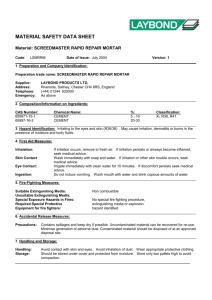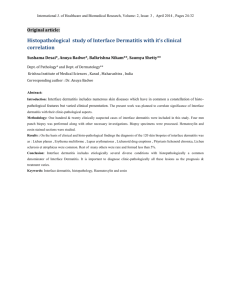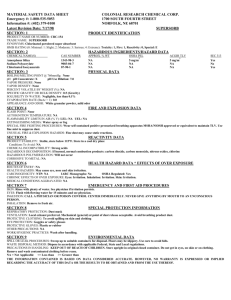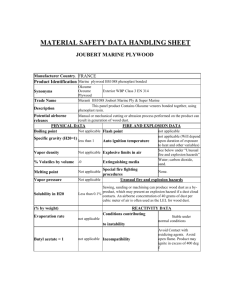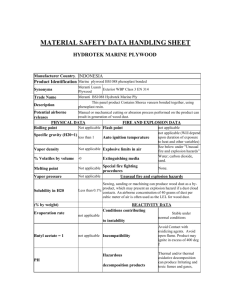Toxic woods HSE information sheet Introduction
advertisement
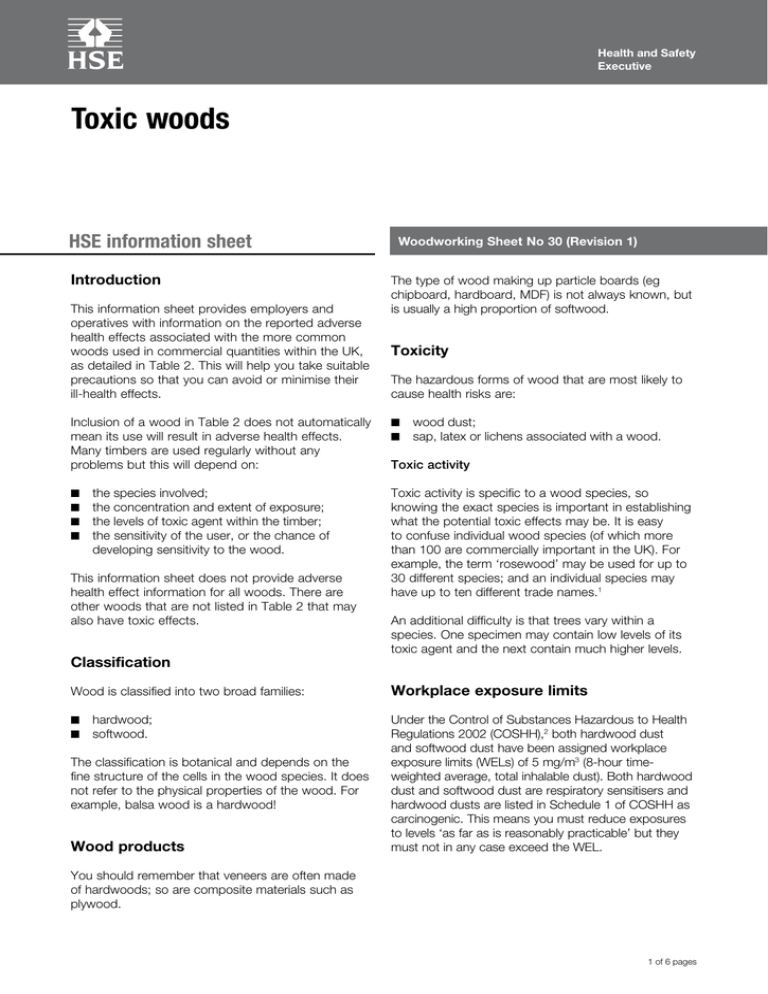
Health and Safety Executive Toxic woods HSE information sheet Introduction This information sheet provides employers and operatives with information on the reported adverse health effects associated with the more common woods used in commercial quantities within the UK, as detailed in Table 2. This will help you take suitable precautions so that you can avoid or minimise their ill-health effects. Inclusion of a wood in Table 2 does not automatically mean its use will result in adverse health effects. Many timbers are used regularly without any problems but this will depend on: ■■ ■■ ■■ n the species involved; the concentration and extent of exposure; the levels of toxic agent within the timber; the sensitivity of the user, or the chance of developing sensitivity to the wood. This information sheet does not provide adverse health effect information for all woods. There are other woods that are not listed in Table 2 that may also have toxic effects. Classification Woodworking Sheet No 30 (Revision 1) The type of wood making up particle boards (eg chipboard, hardboard, MDF) is not always known, but is usually a high proportion of softwood. Toxicity The hazardous forms of wood that are most likely to cause health risks are: ■■ wood dust; ■■ sap, latex or lichens associated with a wood. Toxic activity Toxic activity is specific to a wood species, so knowing the exact species is important in establishing what the potential toxic effects may be. It is easy to confuse individual wood species (of which more than 100 are commercially important in the UK). For example, the term ‘rosewood’ may be used for up to 30 different species; and an individual species may have up to ten different trade names.1 An additional difficulty is that trees vary within a species. One specimen may contain low levels of its toxic agent and the next contain much higher levels. Wood is classified into two broad families: Workplace exposure limits ■■ hardwood; n softwood. Under the Control of Substances Hazardous to Health Regulations 2002 (COSHH),2 both hardwood dust and softwood dust have been assigned workplace exposure limits (WELs) of 5 mg/m3 (8-hour timeweighted average, total inhalable dust). Both hardwood dust and softwood dust are respiratory sensitisers and hardwood dusts are listed in Schedule 1 of COSHH as carcinogenic. This means you must reduce exposures to levels ‘as far as is reasonably practicable’ but they must not in any case exceed the WEL. The classification is botanical and depends on the fine structure of the cells in the wood species. It does not refer to the physical properties of the wood. For example, balsa wood is a hardwood! Wood products You should remember that veneers are often made of hardwoods; so are composite materials such as plywood. 1 of 6 pages Health and Safety Executive Ill-health effects associated with wood Lungs (An explanation of medical terms can be found in Table 1.) ■■ Asthma. ■■ Impairment of lung function. n Rarely – extrinsic allergic alveolitis (a disease with Skin The main effect is irritation that can be caused by skin contact with: ■■ ■■ ■■ n the wood; its dust, its bark (or even lichens growing on the bark); its sap. Irritation can, in some species of wood, lead to nettle rashes or irritant dermatitis. These effects, from direct contact or cross-contamination to other parts of the body by hand, tend to appear on the forearm, backs of the hands, the face (particularly eyelids), neck, scalp and the genitals. On average, they take 15 days to develop. Symptoms usually only persist as long as the affected skin site remains in contact with the source of irritation such as the wood dust or sap etc. Symptoms subside when contact with the irritant is removed. Sensitisation dermatitis is more problematic and is usually caused by skin exposure to fine wood dust of certain species. This is also referred to as allergic contact dermatitis and results in similar skin effects to those produced by skin irritants. However, once sensitised the body sets up an allergic reaction and the skin may react severely if subsequently exposed to even very small amounts of the wood dust. Rashes can appear on skin well away from the original point of contact. Cross-sensitisation may develop where other woods or even non-wood materials produce a similar response. Respiratory and allied effects Wood, especially inhalation of fine dust, can have many effects on the respiratory tract, including: ‘flu-like’ symptoms which can cause progressive lung damage), eg when using western red cedar or iroko. Asthma is of particular concern. Wood dusts can irritate the respiratory tract provoking asthma attacks in sufferers, although effective control of dust levels normally improves the problem. Some wood dusts (eg western red cedar) can cause asthma as a specific allergic reaction. Once sensitised, the body will quickly react if subsequently exposed, even to tiny traces of dust. Unlike irritation, where people can continue to work with the dust once it is controlled to below the level at which irritation occurs, people who become sensitised will not normally be able to continue working with the dust, no matter how low the exposure unless: ■■ respiratory protective equipment (RPE),3 such as air fed respirator, is worn which provides suitable and adequate protection to prevent symptoms of sensitisation recurring; ■■ more frequent health surveillance is undertaken. Eyes ■■ Soreness. ■■ Watering. ■■ Conjunctivitis. Whole body Inhalation of some wood dusts can have general (whole body) effects, eg South African boxwood, although this is rare and not usual for the common commercial woods. Many effects have been described including headache, thirst, nausea, visual disturbance, drowsiness, anaemia and hepatitis. Nose Other ■■ ■■ ■■ ■■ n Rhinitis (runny nose). Violent sneezing. Blocked nose. Nose bleeds. Very rarely – nasal cancer (a recognised industrial disease associated with the inhalation of hardwood dusts). The most common effects arise from irritation, where symptoms usually only persist as long as the sufferer remains in contact with the irritant. Allergic effects, as a consequence of sensitisation to wood dust, can also occur and are often very similar to the irritant effects. Some studies point to very rare adverse health effects, for example effects on germ cells (eg sperm) and disorders of the lymph system (Hodgkin’s lymphoma). Splinter wounds Splinter wounds from a number of woods are slow to heal and often turn septic, eg greenheart, mansonia. This is partly due to the species involved and partly due to secondary infections from bacteria and fungi entering through the skin. 2 of 6 pages Health and Safety Executive Precautions Table 1 Medical terms made simple 1 Find out if the timbers you use have known illhealth effects – contact your suppliers for information. Allergen substance which causes an allergic reaction in the body 2 Consider substituting more harmful toxic woods with less harmful ones, eg substitute the more irritating and sensitising SE Asian teak (Tectona grandis) with a relatively allergen-free teak of the same species grown elsewhere, eg South Africa.2 Anaemia lack of haemoglobin in the red blood cells Asthma severe breathing difficulties Cardiac of the heart Conjunctivitis watery or prickly eyes Dermatitis skin complaint – itching, drying, cracking Extrinsic allergic alveolitis a disease with ‘flu-like’ symptoms Hepatitis infection of the liver Irritant something which may cause inflammation Lesion a mark on or wound of the skin Mucosal membrane lining air passages, eg nose Photosensitisation allergic reaction to light Rhinitis runny nose Sensitisation allergic reaction to a substance which is usually irreversible 3 Use effective local exhaust ventilation4 (LEV) to control exposure to wood dust at source to below the WEL. 4 Use suitable respiratory protective equipment (RPE) where your LEV does not adequately control exposure, or as an interim/emergency measure, eg during maintenance. 5 Use suitable protective clothing and gloves, where appropriate, to protect exposed skin areas where timber known to cause skin problems is used. This clothing should be designed so dust does not become trapped between your clothing and skin. 6 Make sure that your LEV and personal protective equipment (PPE) is properly maintained. 7 Make sure that everyone who uses the LEV, RPE and other PPE has been trained to use it correctly. 8 Make sure that there is good personal hygiene in place and adequate washing facilities for use before breaks and after work. 9 Use after-work conditioning creams to help prevent the development of occupational contact dermatitis. Health surveillance Employers are legally required to provide health surveillance for their employees when it is appropriate to protect their health. It needs to be properly organised and based on a risk assessment and managed by a competent person. This is so that appropriate action(s) can be taken if/when an early case of occupational disease is identified. Skin inspections for woods likely to cause dermatitis are normally appropriate. Respiratory function tests for woods likely to cause occupational asthma also may be appropriate. For more information see ‘References’ and ‘Further reading’. 3 of 6 pages Health and Safety Executive Table 2 More common toxic woods Timber name(s) [ # – used for plywood, $ – softwood ] Use Reported adverse health effects Abura/bahia furniture, shop-fitting, cladding vomiting Afrormosia joinery, furniture, framing, veneers, cladding, boats skin irritation, splinters go septic, nervous system effects Afzelia/doussie stairs, doors, floors, cladding dermatitis, sneezing Agba/tola cladding, general uses skin irritation Alder construction, toys, brush handles dermatitis, rhinitis, bronchial effects Andiroba/crabwood interior joinery sneezing, eye irritation Ash joinery, sports goods decrease in lung function Avodire decorative veneers dermatitis, nose bleeds Ayan/movingui doors, windows, furniture dermatitis Basralocus/angelique marine uses, barrels general unspecific effects Beech # furniture, veneers, tool handles, musical goods dermatitis, decrease in lung function, eye irritation (possibly from bark lichens) Birch # furniture, paper and pulp, veneers, flooring dermatitis on sawing lumber Bubinga veneers, turnery, knife and brush handles dermatitis, skin lesions possible Cedar of Lebanon $ joinery, garden furniture, gates respiratory disorders, rhinitis Cedar (cent/s American) # cabinets, joinery, panelling, boats, cigar boxes allergic contact dermatitis Cedar (western red) $ indoor and outdoor constructions, shingles, planking, boats, panelling, cladding asthma, rhinitis, dermatitis, mucous membrane irritation, central nervous system effects Chestnut (sweet) furniture, kitchen utensils, fences, gates, veneers dermatitis (possibly from bark lichens) Douglas fir #$ flooring, joinery, turnery, boats, vats, veneers dermatitis, splinters go septic, rhinitis, bronchial effects Ebony tool handles, musical and sports goods mucous membrane irritation, dermatitis, possibly a skin sensitiser Freijo/cordia interior furniture possibly a skin sensitiser Gaboon/okoume # blockboard, veneers, packing cases, cigar boxes asthma, cough, eye irritation, dermal effects (hands, eyelids) Gedu nohor/edinam furniture, boats, coffins dermatitis (rare) Greenheart marine uses, axe handles, factory flooring, sports goods splinters go septic, cardiac and intestinal disorders, severe throat irritation Guarea boats, furniture and cabinet making skin and mucous membrane irritation Gum (southern blue) packing cases, construction, pulp, fibre-board dermatitis Hemlock (western) $ construction, joinery bronchial effects, rhinitis Idigbo # interior and exterior joinery, furniture possible irritant Iroko construction, bench tops, marine uses, joinery asthma, dermatitis, nettle rash Larch $ construction, fencing stakes, stairs, flooring nettle rash, dermatitis (possibly from bark lichens) 4 of 6 pages Health and Safety Executive Timber name(s) [ # – used for plywood, $ – softwood ] Use Reported adverse health effects Limba # frames, drawer sides, coffins, veneers, furniture splinters go septic, nettle rash, nose and gum bleeding, decrease in lung function Mahogany furniture, cabinet work, boats dermatitis, respiratory disorders, mucous membrane irritation Makore # planks, floors, panelling, doors, furniture, boats dermatitis, mucous membrane and respiratory tract irritation, central nervous system and blood effects Mansonia cabinet making, turnery, sports goods splinters go septic, skin sensitisation, irritation, respiratory disorders, nose bleeds, headache, cardiac disorders Maple flooring, furniture, sports goods decrease in lung function Meranti/lauan (various) # boats, flooring, furniture, joinery skin irritation Oak (various) furniture, joinery, flooring, panelling, barrels asthma, sneezing, eye irritation Obeche # model-making, musical goods, picture frames and rails skin and respiratory tract irritation, nettle rash, dermatitis (handling articles), feverish, sneezing, wheezing Opepe construction, marine uses, flooring dermatitis, mucous membrane irritation, central nervous system effects (eg giddiness, visual effects), nose bleeds and blood spitting Padauk turnery, carving, boats, flooring species-dependant: itching, eye irritation, vomiting, swelling (eg eyelids) Peroba construction, joinery, turnery skin and mucous membrane irritation, systemic effects (eg headache, nausea, stomach cramp, weakness), blisters Pine (many species) #$ construction, stairs, doors, furniture, pallets skin irritation (may cause photosensitisation) decrease in lung function Poplar # shelves, toys, matches, pallets, wood wool sneezing, eye irritation, may cause blisters Ramin furniture, mouldings, toys, joinery dermatitis (possibly from bark) Rosewood (many species) furniture, cabinets, musical goods, jewellery dermatitis, respiratory disorders. Effects may arise from handling wood Sapele # furniture, mouldings, flooring, veneers skin irritation Spruce (several species) #$ construction, telegraph poles, packings, pallets respiratory disorders, possible photosensitisation Teak marine fittings, joinery, scrubbing towers dermatitis (potent, even after seasoning), nettle rash, respiratory disorders Utile furniture, cabinet making, veneers, mouldings skin irritation Walnut (not African) furniture, fancy goods, gun-stocks, veneers sneezing, rhinitis, dermatitis from nut shells and roots Wenge panelling, furniture, kitchens, veneers splinters go septic, dermatitis, central nervous system effects (eg giddiness, drowsiness, visual disturbance), abdominal cramps Whitewood (American) # construction, flooring, joinery dermatitis Yew $ carving, turnery, cabinet making, sports goods dermatitis, systemic effects (eg headache, blood pressure drop), cardiac effects 5 of 6 pages Health and Safety Executive References Further information 1 Hausen B Woods injurious to human health – a manual W de Gruyter, Berlin 1981 For information about health and safety, or to report inconsistencies or inaccuracies in this guidance, visit www.hse.gov.uk/. You can view HSE guidance online and order priced publications from the website. HSE priced publications are also available from bookshops. 2 Control of substances hazardous to health (Fifth edition). The Control of Substances Hazardous to Health Regulations 2002 (as amended). Approved Code of Practice and guidance L5 (Fifth edition) HSE Books 2005 ISBN 978 0 7176 2981 7 www.hse.gov.uk/pubns/books/L5.htm 3 Selection of respiratory protective equipment suitable for use with wood dust Woodworking Information Sheet WIS14(rev1) HSE 2012 www.hse.gov.uk/pubns/WIS14.htm British Standards can be obtained in PDF or hard copy formats from BSI: http://shop.bsigroup.com or by contacting BSI Customer Services for hard copies only Tel: 020 8996 9001 email: cservices@bsigroup.com. 4 Wood dust: Controlling the risks Woodworking Information Sheet WIS23(rev1) HSE 2012 www.hse.gov.uk/pubns/WIS23.htm This guidance is issued by the Health and Safety Executive. Following the guidance is not compulsory, unless specifically stated, and you are free to take other action. But if you do follow the guidance you will normally be doing enough to comply with the law. Health and safety inspectors seek to secure compliance with the law and may refer to this guidance. Further reading This document is available at: www.hse.gov.uk/pubns/wis30.htm. EH40/2005 Workplace exposure limits: Containing the list of workplace exposure limits for use with the Control of Substances Hazardous to Health Regulations (as amended) Environmental Hygiene Guidance Note EH40 (Second edition) HSE Books 2011 ISBN 978 0 7176 6446 7 www.hse.gov.uk/pubns/books/EH40.htm © Crown copyright If you wish to reuse this information visit www.hse.gov.uk/copyright.htm for details. First published 11/12. Health surveillance at work HSG61 HSE Books 1999 ISBN 978 0 7176 1705 0 www.hse.gov.uk/pubns/books/HSG61.htm Woods B, Calnan C D ‘Toxic woods’ British Journal of Dermatology 1976 94 Supplement 13 Goldsmith D, Shy C M ‘Respiratory health effects from occupational exposure to wood dusts’ Scandinavian Journal of Work Environment and Health 1988 1 4 (1) 1–15 Timbers – their properties and uses Timber Research and Development Association (TRADA) leaflet 2002, section 2/3, sheet 10 BS EN 13556:2003 Round and sawn timber. Nomenclature of timbers used in Europe British Standards Institution HSE’s Woodworking website has more information on wood dust www.hse.gov.uk/woodworking/ See also the HSE COSHH website www.hse.gov.uk/coshh/index.htm and asthma website www.hse.gov.uk/asthma Published by the Health and Safety Executive WIS30(rev1) 11/12 6 of 6 pages


